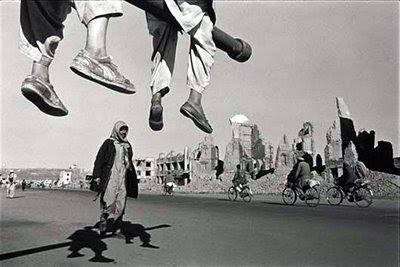James Nachtweys work has shown to the world the devastation and hurt war and poverty creates and has retold many stories of those who suffer and have suffered from such tragedy. The images he photographs are sometimes unbelievable and hard to think are reality but that is what makes his work so powerful and moving. I truly admire what he has captured as it does not leave room for lies or misunderstanding, and shows the raw truth of a world I and a large majority of the world have never seen before. His work also shows that photography is not always about what pleases the eye and what we find beautiful or pleasant. This career Nachtwey has chosen must be so satisfying in a way as he is able to retell peoples stories and experiences through his images and inform so many people of the worlds reality, but it must be so difficult as its not only his camera that is capturing the images but also his eye and mind. "I have been a witness, and these pictures are my testimony. The events I have recorded should not be forgotten and must not be repeated". The way Nachtwey connects with the people he photographs is not by written contract or formal discussion but by his body language or by little or no words at all. People can sense he is genuine and do realise that if 'they' as victims let him into their life it allows them to pass on their own story. When Natchwey photographs he is very unintrusive but at the same time is not afraid to be completely participative despite the danger involved. "Asking if I feel fear is the same as asking a marathon runner if he feels pain...its just how you manage it".
Leibovits work is similar to Nachtweys in the sense that through her photography she too can send a message. The photograph of Woopie Goldberg is a great example of this, as although she is just in a bath of milk, if you look at it deeper you can see that there is a great meaning behind it. At the time this was taken Goldberg was a black woman who was breaking through into the white celebrity scene and Leibovitz wanted to capture this by having her emerging from a bath of white milk. Leibovitz puts a lot of research into her work and there is a lot of planning involved with her shots to make sure she portrays the right message.
I think that through both of these amazing photographers Annie Leibovitz and James Nachtwey we can learn a lot as visual anthropology students. Through Natchwey it can be learnt that being participative when out researching and taking photographs is very important in order to capture truth and very real moments but in doing so you must have respect and not be intrusive. Gaining the trust of your subject is of huge importance and can allow you make better use of the situation at hand . Leibovitz is also a great example of someone who gains trust with the people she photographs."When I say I want to photograph someone it means I want to get to know them". Annie believes that you must be able to connect with the person you are photographing as it makes both companies feel more comfortable which will help create pleasing results.
Another idea we can learn from Leibovitz is that being creative is a very important and useful skill to have. Leibovitz is a very creative person and has captured some amazing results due to her abstract but amazing way of thinking and ability to manipulate normal situations to her advantage. This is very inspiring and encourages, me as a visual anthropology student, to want to think outside of the square and try and capture more unique photographs.
Also, we can learn through these two people is the importance of research. Both photographers put a lot of time into researching what they want or plan to photograph whether it be learning about the person or place they are going to photograph or about the message they want to portray through their work. They do not just arrive at their destination and start cold and begin to take photos. There is a lot of planning that goes into what they photograph and how it is done.
Lastly, one of the most important pieces of advice we can take away from James Natchwey and Annie Leibovitz is to always carry your camera. From a young age these photographers always carried cameras where ever they went and I feel that this is very important as you do not always know when you are going to get the perfect opportunity to capture a great moment. It is better to be safe than sorry!
Photograph reference links:
http://www.ilahi.org/modules.php?name=Forums&file=viewtopic&t=70588
http://www.flickr.com/photos/34946092@N07/3320453600/
http://leegrantphotography.files.wordpress.com/2009/06/cp_02.jpg?w=542&h=368
http://shiitehappens.wordpress.com/category/music/
http://heyharriet.blogspot.com/2009_03_01_archive.html
http://rsemel.wordpress.com/
http://viistories.com.s3.amazonaws.com/data/dailyPhoto/417.png




























